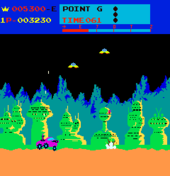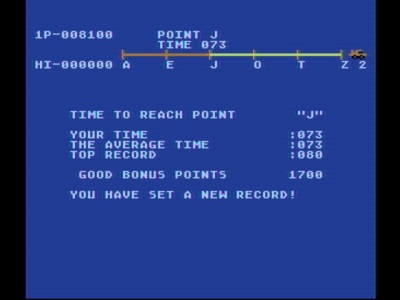Moon Patrol has always been an arcade favorite of mine – I love the crazy looking aliens (especially the monsters that live in the craters),

the catchy background music that plays, and the way your moon buggy hugs the road with each of it’s six wheels. I remember first playing it at our local arcade – The Electronic Cave.

I was pretty much hooked right away by the colorful graphics and fun gameplay that combines driving with shooting. It’s a horizontally scrolling shooter that has you jumping over obstacles on the ground as you shoot down enemies above as you try to drive your buggy from one side of the moon to the next as quickly as possible.
The backstory is simple – you are a police officer in Luna City, and you must finish your patrol of the dangerous Sector 9 in record time. Sector 9 is full of baddies dropping

bombs from above, dishing out attacks from craters on the surface, tanks looking to blow you away, and even missiles that will attack from behind when you least expect it. Who knew the Moon could be such a rough and tumble place for law enforcement? Don’t worry though – you’ve got your trusty patrol buggy armed with guns that shoot above and forward, as well as speed control and jumping capability to get you over those Moon craters, boulders and mines that dot the lunar surface.
For the uninitiated, Moon Patrol is an arcade game distributed by Williams electronics in 1982. The game was developed by Irem, the same company that brought you R-Type and Kung-Fu Master. Controls consist only of a two-way joystick, a fire button, and a jump button. Pushing the stick forward will speed the buggy up, and moving left will slow it down. Pressing the jump button will make the buggy leap into the air – the faster the buggy is travelling, the longer the jump will be.

Careful speed control is essential to clearing the craters and rocks that you must avoid. The fire button will shoot a missile directly up from your buggy, and will also fire a short-range burst in front of the buggy. Each button press fires one round, holding it down will not grant you rapid fire. There are three warning light indicators at the top of the screen to help you out – the top light warns of enemies approaching above, the middle light indicates mines ahead, and a lit lower light means a missile is coming from behind. I don’t know how many times I played this game without ever knowing what the lights meant – but it was a lot.
The game is divided into 2 different courses – a beginner and an champion course. Each course is further divided into 26 checkpoints, one for each letter of the alphabet. If you lose a buggy (due to getting hit by any manner of enemy fire, hitting a boulder, falling into a crater, or running over a landmine), you will start your next buggy at the last letter you passed.

Letters E, O, J, T, and Z represent major checkpoint. At these locations, the game will pause a moment to award bonus points. An average time between major checkpoints is preset and you earn bonus points for every second you are under the average time. So, it pays to finish quickly (and not lose any buggies while doing it!). Finishing the beginner course will get you a special bonus, and then it is on to the champion course which will repeat itself should you manage to finish it.
Irem’s Kung-Fu Master and Moon Patrol were both designed by Takashi Nashiyama, who went on to work for arcade giants Capcom and SNK after leaving Irem. He has worked on many hit game series, including Mega Man, The Art of Fighting, Fatal Fury, and Metal Slug. I can’t help but notice a striking similarity between the Metal Slug vehicle and our beloved Moon Patrol buggy – could this be Mr. Nashiyama’s tip of the hat to his first game? He is still in the video game business today, as the president of Dimps, a game development house he founded.

As it enjoyed popularity in the arcade, Moon Patrol was ported to many video game consoles and home computers including the Apple II, the Atari 8-bit home computers, Atari 2600, Atari ST, Commodore 64 & VIC-20, MSX, IBM PC, TI-99/4A, and Tandy Color Computer, and of course the Atari 5200.

It’s worth noting that the Atari 8-bit home computer version is nearly identical to the 5200 version – but the 5200 version does take advantage of the CX-52 analog joystick. The buggy responds to varying degrees of pressure on the stick – a slight nudge left slows the buggy only slightly, while full pressure right will put the pedal to the metal and speed things up quickly. Jump and shoot have been assigned to the top and bottom fire buttons, respectively, which many players prefer over having jump assigned to the up joystick position. I didn’t have any troubles with the CX-52 and this game – having a masterplay adapter or clone won’t really hurt, but it isn’t necessary here.
The 5200 version, released by Atari in 1983, is an enjoyable port that doesn’t leave out any of the important arcade features. You’ll hear catchy theme music that is very similar to the arcade game.  The lunar surface will pass by with beautiful parallax scrolling (an effect that Moon Patrol is credited as being the first game to have), and all of the bad guys from the arcade game are represented here as well. Both courses are here, and you can choose which to start on. The continue feature from the arcade is here as well. There is a bit of a difference in the look of the buggy itself, as well as the enemies, but they are still quite recognizable and their behavior is thankfully the same. If you like the arcade game, you’ll find this port to be just as enjoyable.
The lunar surface will pass by with beautiful parallax scrolling (an effect that Moon Patrol is credited as being the first game to have), and all of the bad guys from the arcade game are represented here as well. Both courses are here, and you can choose which to start on. The continue feature from the arcade is here as well. There is a bit of a difference in the look of the buggy itself, as well as the enemies, but they are still quite recognizable and their behavior is thankfully the same. If you like the arcade game, you’ll find this port to be just as enjoyable.
As a fairly common cartridge to track down, and with it being a solid and fun to play arcade port, Moon Patrol belongs in your 5200 collection. Get out there and make Luna City safe again!
Links and bits of interest:
Want to see your 5200 game look even more arcade-like? AtariAge members TIX, EnderDude and doctorclu have done a sprite hack to make the buggy and aliens look a bit more accurate to the original. It is nicely done, and certainly worth a play on your emulator or AtariMax cart! Check it out here
The Electronic Cave arcade is a fondly remembered place for me, and I still enjoy many of the games I first played there. The token image I used above came from this pretty cool site
Our buddy (and former host of the 5200 Super Community Podcast) Ar Kay made the sweet 3d diorama you saw as my background image for this article. Check out his video